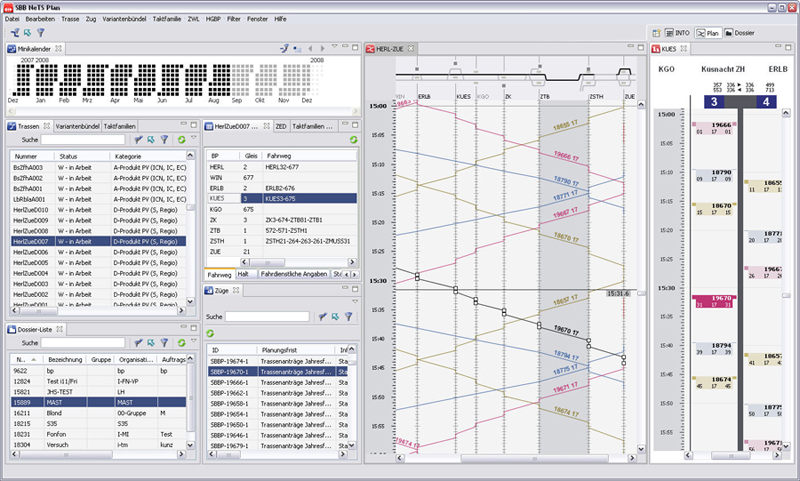Every year Swiss Federal Railways (SBB) transports around 285 million passengers and 60 million tonnes of freight along more than 3000 kilometers of track which connects a total of 824 stations. SBB statistics indicate that 96.2% of the trains run on time. A high-quality service of this kind is obviously the result of very careful planning.
In order to organize the 17,000 passenger and freight trains which travel through the country every day, SBB has relied both on its extensive experience and on software. Since July 2007, SBB has been testing a new timetabling system called NeTS. NeTS stands for "network-wide track system" and has been developed by Netcetera in close cooperation with the client SBB, the IT service provider Ergon, and the design agency NOSE. Following successful field trials, NeTS is scheduled to replace the current annual planning system at the end of June 2008. The 2010 timetable will be the first to be created using NeTS.
Vital Experience and New Software Help to Meet Complex Challenges
Currently the 300 or so planners in various SBB offices who are responsible for developing the passenger and freight timetables work with a variety of different planning systems and on the basis of the company's 125 years of experience. This experience is vital. Without it, planning the journeys of thousands of passenger and goods trains and ensuring that they arrived in the right place, at the right time and on the right track would present numerous problems. Of course, SBB is already using a software system for this purpose. However, the existing system has reached its technical limits and can no longer be developed to meet the challenges of the future. For this reason, SBB decided at the end of 2005, following an extensive tendering process, to commission Netcetera to develop a new timetabling system with their partners Ergon and NOSE.
By the end of 2009, SBB will have a unique, future-proof software solution designed specifically to meet its needs. The system will take four years and thousands of man days to develop. Netcetera is responsible for coordinating the close and successful partnership between the client and the project team members. As a result of the highly positive nature of the collaboration, the SBB planners were able to start field-testing NeTS in the autumn of 2007 and are now providing valuable feedback from their practical experience of the system to the developers.
User-Friendly, Detailed and Precise
The new system calculates a train's journey time on the basis of its exact route, taking into account curves, the specific track and even topographical features. The graphical support provided by NeTS makes the work of the SBB planners significantly easier. The new system integrates three previous individual solutions for planning routes, nodes (stations) and maintenance work.
One of the Largest Eclipse RCP Projects in Switzerland
NeTS will not only be able to represent reality more accurately, but will also have seamless interfaces to existing SBB systems, as a result of its open architecture. One of these systems is, for example, the train movement calculation system which calculates the exact journey times on the basis of the route and its topography. Each section of track is assigned an accurately calculated travel time. Buffer time for travel and stops can be monitored and is clearly indicated on the screen. The software also allows for precise daily planning using different routes, stops and types of trains. Numerous integrated support functions are also available to give SBB an overview of its highly detailed timetable. It goes without saying that huge volumes of data have to be processed to a high level of efficiency in order to display the complex, comprehensive plans.
NeTS is currently one of the largest Eclipse Rich Client Platform projects in Switzerland. It has been developed on the basis of current SOA and Java EE standards to ensure that it is open and has a long service life. IBM Websphere, Oracle and Hibernate are some of the other applications that are being used in the system. NeTS is a team effort which SBB, Netcetera and their partners will be proud of long after 2010.
 The new NeTS planning system for SBB allows every route to be planned from end-to-end, including branch, arrival, departure and main lines. NeTS includes a track diagram function and a time and route graph for route planning. The main track allocation function of NeTS will in future allow train movements into the stations (referred to as nodes) to be planned with complete precision.
The new NeTS planning system for SBB allows every route to be planned from end-to-end, including branch, arrival, departure and main lines. NeTS includes a track diagram function and a time and route graph for route planning. The main track allocation function of NeTS will in future allow train movements into the stations (referred to as nodes) to be planned with complete precision.